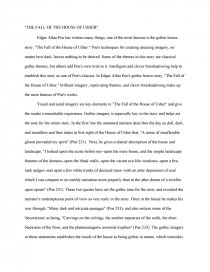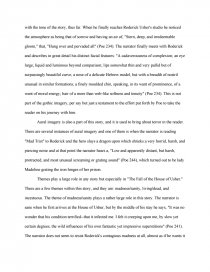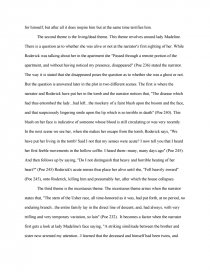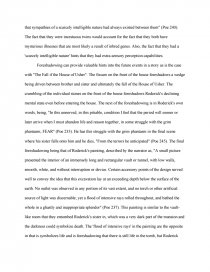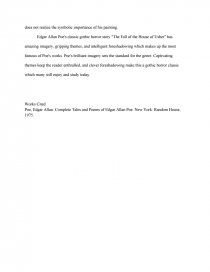The Fall Of The House Of Usher Analysis
Essay by 24 • June 1, 2011 • 1,555 Words (7 Pages) • 2,477 Views
"THE FALL OF THE HOUSE OF USHER"
Edgar Allan Poe has written many things, one of the most famous is the gothic horror story, "The Fall of the House of Usher." Poe's techniques for creating amazing imagery, no matter how dark, leaves nothing to be desired. Some of the themes in this story are classical gothic themes, but others add Poe's own twist to it. Intelligent and clever foreshadowing help to establish this story as one of Poe's classics. In Edgar Allan Poe's gothic horror story, "The Fall of the House of Usher," brilliant imagery, captivating themes, and clever foreshadowing make up the most famous of Poe's works.
Visual and aural imagery are key elements in "The Fall of the House of Usher" and give the reader a remarkable experience. Gothic imagery is especially key in the story and helps set the tone for the entire story. In the first line the unnamed narrator describes the day as dull, dark, and soundless and then states at first sight of the House of Usher that, "A sense of insufferable gloom pervaded my spirit" (Poe 231). Next, he gives a dismal description of the house and landscape, "I looked upon the scene before me--upon the mere house, and the simple landscape features of the domain--upon the bleak walls--upon the vacant eye-like windows--upon a few rank sedges--and upon a few white trunks of decayed trees--with an utter depression of soul which I can compare to no earthly sensation more properly than to the after-dream of a reveller upon opium" (Poe 231). These two quotes have set the gothic tone for the story and revealed the narrator's contemptuous point of view so very early in the story. Once in the house he makes his way through, "Many dark and intricate passages" (Poe 233), and also notices some of the 'decorations' as being, "Carvings on the ceilings, the sombre tapestries of the walls, the ebon blackness of the floor, and the phantasmagoric armorial trophies" (Poe 233). The gothic imagery in these statements establishes the inside of the house as being gothic in nature, which coincides with the tone of the story, thus far. When he finally reaches Roderick Usher's studio he noticed the atmosphere as being that of sorrow and having an air of, "Stern, deep, and irredeemable gloom," that, "Hung over and pervaded all" (Poe 234). The narrator finally meets with Roderick and describes in great detail his distinct facial features: "A cadaverousness of complexion; an eye large, liquid and luminous beyond comparison; lips somewhat thin and very pallid but of surpassingly beautiful curve; a nose of a delicate Hebrew model, but with a breadth of nostril unusual in similar formations; a finely moulded chin, speaking, in its want of prominence, of a want of moral energy; hair of a more than web-like softness and tenuity" (Poe 234). This is not part of the gothic imagery, per say but just a testament to the effort put forth by Poe to take the reader on his journey with him.
Aural imagery is also a part of this story, and it is used to bring about terror in the reader. There are several instances of aural imagery and one of them is when the narrator is reading "Mad Trist" to Roderick and the hero slays a dragon upon which shrieks a very horrid, harsh, and piercing noise and at that point the narrator hears a, "Low and apparently distant, but harsh, protracted, and most unusual screaming or grating sound" (Poe 244), which turned out to be lady Madeline grating the iron hinges of her prison.
Themes play a large role in any story but especially in "The Fall of the House of Usher." There are a few themes within this story, and they are: madness/sanity, living/dead, and incestuous. The theme of madness/sanity plays a rather large role in this story. The narrator is sane when he first arrives at the House of Usher, but by the middle of his stay he says, "It was no wonder that his condition terrified--that it infected me. I felt it creeping upon me, by slow yet certain degrees, the wild influences of his own fantastic yet impressive superstitions" (Poe 241). The narrator does not seem to resist Roderick's contagious madness at all, almost as if he wants it for himself, but after all it does inspire him but at the same time terrifies him.
The second theme is the living/dead theme. This theme revolves around lady Madeline. There is a question as to whether she was alive or not at the narrator's first sighting of her. While Roderick was talking about her in the apartment she "Passed through a remote portion of the apartment, and without having noticed my presence, disappeared" (Poe 236) stated the narrator. The way it is stated that she disappeared poses the question as to whether she was a ghost or not. But the question is answered later in the plot in two different scenes. The first is where the narrator and Roderick have put her in the tomb and the narrator notices that, "The disease which had thus entombed the lady...had left...the mockery of a faint blush upon the bosom and the face, and that suspiciously lingering smile upon the lip which is so terrible in death" (Poe 240). This blush on her face is indicative of someone whose blood is still circulating or was very recently. In the next scene we see her, when she makes her escape from the tomb, Roderick says, "We have put her living in the tomb! Said I not that my senses were acute? I now tell you that I heard her first feeble movements in the hollow coffin. I heard them--many, many days ago" (Poe 245). And then follows up by saying, "Do I not distinguish
...
...
